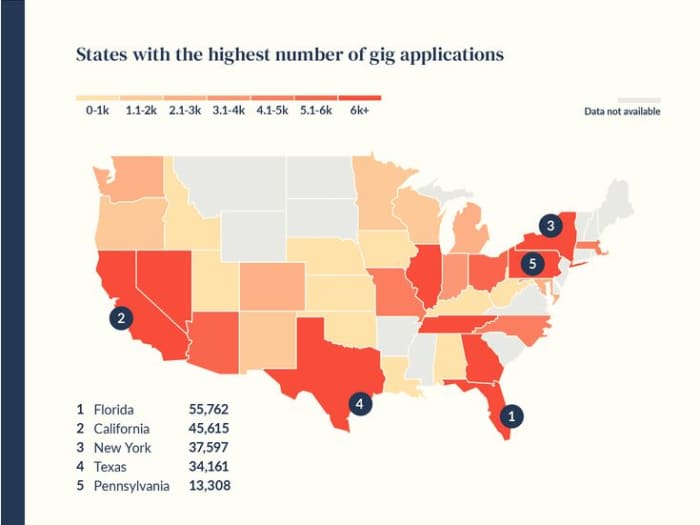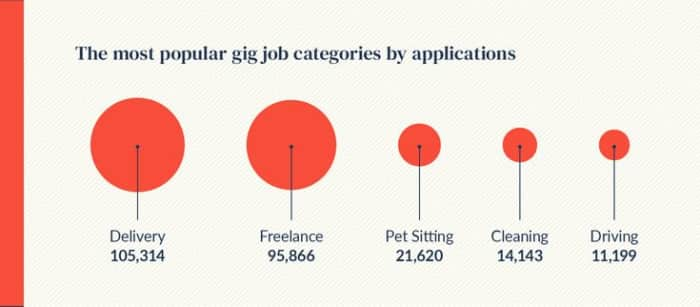Even if some historians have already depicted a future without (much) work and with a huge amount of free time, it will take years (perhaps decades) to forget about work altogether—if this ever happens, of course. As long as people need to earn money to get by and/or buy things, they will look for jobs that help them pay the bills and pay for their (expensive/inexpensive) hobbies. It’s sure though that the concept and the meaning of work have gone through changes, and individual workers have contributed as much to those changes as new technologies. While traditional 9-to-5 jobs still exist and unquestionably prevail over other types of jobs, numerous people have already taken up side jobs in the so-called gig economy that is on the rise in the States. Without further ado, let’s take a look at the U.S. labor market first from a historical standpoint, which also allows us to discuss some predictions.
Worker’s rights today: how we got here
On the first Monday of September, people light their grill probably for the last time in the summer and celebrate Labor Day. You may not know but this holiday originates in the labor movement that first shook the Midwest and then the entire country. At the end of the 19th century, workers had enough of toiling about 12 hours a day for seven days a week for low wages—even children were doing shifts in factories. To bring about changes, they got organized, stood up for themselves, and demanded shorter workdays and -weeks. They marched for the first time on the streets of New York City in 1882. And when the railroad workers in Pullman went on strike on May 1894, the pressure on President Grover Cleveland increased, so he signed a bill and made Labor Day a national holiday. Thanks to them, many of us work only 8 hours a day and five days a week today. (Fun fact: workers originally wanted to celebrate Labor Day on the first of May, when the celebration in most European countries takes place.)
Trade unions, although weakened by policies and legislation, still fight for workers’ rights. What’s more, the coworkers of some digital (media) companies have also started to unionize. What the future brings for them, it’s hard to tell. What’s certain is that today the once revolutionary demands seem outdated and workers want something else than spending eight hours in a cubicle or workshop on a daily basis. The results of some research illustrate that the traditional 9-to-5 model is contested and evidently undermined by the gig economy as more people set out to do flexible side hustles. Consequently, the next chapter in the book on labor rights will surely focus on issues related to the new way of working.
How does the U.S. labor market look?
The unemployment rate was at a historic low with 3.7 percent at the end of 2018, which then increased by 0.2 points by January 2019. The U.S. hasn’t seen anything like this for 50 years. It was reported that there were more job openings in the majority of the states than people to fulfill them. Alaska and North Dakota were exceptions, though. Industries such as healthcare, construction and service (retail) generated most of the growth. Despite the rise in job employment, work shortages were detected in some sectors and industries. Nonetheless, those skilled workers in engineering, finance, sales, construction and manufacturing, information technology and trucking did not have such a difficult time to find employment in their fields. As of July 2019, the unemployment rate has decreased to 3.7 percent again. Statistics also show that 36 percent (one third) of U.S. workers, which approximately 57 million people, do side hustle jobs. Those workers don’t comprise a homogenous group, they are full-time workers (24%), part-time workers (49%), and some take on multiple jobs.

The states where most AppJobs users are based.
What to know about the gig economy in the U.S.
The gig economy continues to grow in the USA. Among gig workers who tend to be independent contractors, there are students, retired people, and anything in between. They do take their share of the profit produced by the sharing economy because they were laid off recently, are between jobs, would like to do more flexible work, or want to earn money by pursuing their hobbies. Considering the fact that Millennials (including the members of Generation Y and Z) are early adopters when it comes to apps and other technological products, they account for a large percentage of the gig economy’s current workforce. Despite the downside of the gig economy, it still creates them (especially for creative professionals) opportunity to launch their own business, hence becoming their own bosses while earning money using all their skills. Their initial pay might be considered low by many, but they could still make more than an unpaid intern, for example. They basically cut out the middleman aka organizations that would promise them relevant experience but not a decent wage or salary. (In reality, the children of affluent parents are far more likely to be able to afford to do unpaid internships that are necessary to get a paid job in their chosen industries later on.)
Regardless of age, anyone with some aspiration to change career or make their childhood dreams come true can try their luck in the gig economy. Many of the jobs available don’t necessarily require previous work experience, particular skills, or a degree. While we can’t draw any generalisations with the data gathered on AppJobs, the results shown in the infographics below could give an idea about the popular types of side hustles in the USA. According to the findings, the popular (easy) gig jobs that generate quick cash are delivery, freelance, pet-sitting, cleaning, and driver jobs.

The most popular side hustle categories on AppJobs.
Check out delivery jobs in Milwaukee, Miami, Riverside, Nashville, Oklahoma City, Omaha, Wichita, Columbus, Athens, Laredo, Tacoma, Aurora, Rochester, Worcester, and many other cities in the USA.
Check out pet-sitting jobs in Philadelphia, Chicago, Amarillo, Aurora, Omaha, Denver, Albuquerque, San Jose, Reno, Pittsburgh, Austin, San Francisco, and many other cities across the USA.
Check out cleaning jobs in Miami, Atlanta, New York City, Denver, El Paso, Fresno, Fort Worth, Phoenix, Atlanta, Tallahassee, Portland, and many other cities in the USA.
Check out driver jobs in Austin, Philadelphia, Cleveland, Denver, Portland, Seattle, Baltimore, Scottsdale, Norfolk, Louisville, Memphis, Akron, Richmond, Tempe, and many other cities in USA.
Gig economy: is it the future of work?
According to some people, it definitely is. It’s also worthwhile mentioning that ca. 100 years ago, nobody would expect that people working in the agricultural sector would not even make up five percent of the workforce by 2017. Yet it happened. While the recent changes empower people to take more control of their life, the legal system still needs to catch up with the latest developments in the labor market to protect gig workers and their rights. As the number of people engaging in freelance work growing, the future may belong to them. Forbes has published an article about freelancers, and they reference a study that shows that 36 percent of U.S. Americans prefer being their own boss in spite of all the disadvantages of doing freelance work, such as the lack of retirement plans and insurance, etc. (No worries, we have some resources on retirement schemes and insurance.) Gig workers in the USA and the UK have already challenged some platforms they work with, and some legislation (e.g. Freelancing is not Free in the USA) has already passed, but it’s predicted that more laws and policies will be written to explicitly react to the changes partially caused by the emergence of apps – and Internet-based jobs. We’ll keep you posted.
Check out freelance jobs in Los Angeles, Miami, New York City, San Francisco, Boston, Denver, Houston, Cleveland, and many other cities in the States.
Want to be part of the change?
You may be new to side hustling but probably plenty of opportunities are available in your city. Read about them and try a few of them. We’d also like to encourage you to spend some on our blog where you learn about all the different types of part-time, student and weekend jobs you could do on your own time.
READ MORE
• Freelance: part-time or full-time? Turning a side hustle into a regular job!
• Asking the Question ‘How to Start Making Money Online?’ Here Comes Your Answer!
• 3 Ideas for Stay-At-Home Moms and Dads to Start Making Money
• 5 Ways to Make Money Using Your Phone
• 9 Platforms to Become an Online (English) Teacher with No Experience or Degree
• How to Get out of Debt and Achieve Financial Freedom – 20 Experts Reveal
DON’T FORGET TO SUBSCRIBE TO OUR YOUTUBE CHANNEL!
Photo by Augusto Navarro on Unsplash